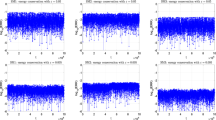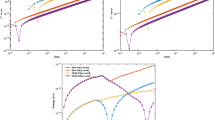Abstract
The symplectic algorithm and the energy conservation algorithm are two important kinds of algorithms to solve Hamiltonian systems. The symplectic RungeKutta (RK) method is an important part of the former, and the continuous finite element method (CFEM) belongs to the later. We find and prove the equivalence of one kind of the implicit RK method and the CFEM, give the coefficient table of the CFEM to simplify its computation, propose a new standard to measure algorithms for Hamiltonian systems, and define another class of algorithms—the regular method. Finally, numerical experiments are given to verify the theoretical results.
Similar content being viewed by others
References
Arnold, V. I. Mathematical Methods of Classical Mechanics, Springer, New York (1978)
Ge, Z. and Marsden, J. E. Lie-Possion Hamilton-Jacobi theory and Lie-Poisson intergrators. Phys. Lett. A, 133(3), 134–139 (1988)
Feng, K. On difference schemes and symplectic geometry. Proceedings of Symposium Differential Geometry and Differential Equations-Computation of Differential Equations, Science Press, Beijing, 42–58 (1985)
Feng, K. Difference schemes for Hamiltonian formalism and symplectic geometry. J. Comput. Math., 4, 279–289 (1986)
Feng, K. How to compute properly Newton’s equation of motion. Proceedings of 2nd Conference on Numerical Methods for Partial Differential Equations, World Scientific, Singapore, 15–22 (1992)
Feng, K. and Qin, M. Z. Symplectic Geometric Algorithms for Hamiltonian Systems (in Chinese), Zhejiang Science and Technology Press, Hangzhou (2003)
Sanz-Serna, J. M. Runge-Kutta schemes for Hamiltonian systems. BIT Numerical Mathematics, 28, 877–883 (1988)
Sanz-Serna, J. M. and Calvo, P. M. Numerical Hamiltonian Problems, Chamman Hall, London (1994)
Lasagni, F. M. Canonical Runge-Kutta methods. Z. Angew. Math. Phys., 39, 952–953 (1988)
Suris, Y. B. On the preservation of the symplectic structure in the course of numerical integration of Hamiltonian systems (in Russian). Numerical Solution of Ordinary Differential Equations, USSR Academy of Sciences, Moscow, 148–160 (1988)
Sun, G. Symplectic partitioned Runge-Kutta methods. J. Comput. Math., 11, 365–372 (1993)
Sun, G. Construction of high order symplectic Runge-Kutta methods. J. Comput. Math., 13, 40–50 (1995)
Tang, Y. F. The symplecticity of multi-step methods. Comput. Math. Appl., 25, 83–90 (1993)
Tang, Y. F. Symplectic computation of Hamiltonian systems (I). J. Comp. Math., 20, 267–276 (2002)
Hairer, E. Conjugate-symplecticity of linear multistep methods. J. Comp. Math., 26, 657–659 (2008)
Bridges, T. J. and Reich, S. Numerical methods for Hamiltonian PDEs. J. Phys. A: Math. Gen., 39, 5287–5320 (2006)
Zhong, W. X. Time domain FEM and symplectic conservation (in Chinese). Journal of Mechanical Strength, 27(2), 178–183 (2005)
Chen, C. M. and Tang, Q. Study of finite elements for nonlinear Hamiltonian systems. The Fifth International Conference on PDE’s and Numerical Analysis, Changsha (2006)
Tang, Q. and Chen, C. M. Energy conservation and symplectic properties of continuous finite element methods for Hamiltonian systems. Appl. Math. Comput., 181, 1357–1368 (2006)
Tang, Q., Chen, C. M., and Liu, L. H. Continuous finite element methods for Hamiltonian systems. Appl. Math. Mech.-Engl. Ed., 28(8), 1071–1080 (2007) DOI 10.1007/s10483-007-0809-y
Tang, Q. and Chen, C. M. Space-time finite element method for the Schrodinger equation and its conservation. Appl. Math. Mech.-Engl. Ed., 27(3), 335–340 (2006) DOI 10.1007/s10483-006-0308-z
Chen, C. M., Tang, Q., and Hu, S. F. Finite element method with superconvergence for nonlinear Hamiltonian systems. J. Comp. Math., 29, 167–184 (2011)
Quispel, G. R. W. and McLaren, D. I. A new class of energy-preserving numerical integration methods. J. Phys. A: Math. Theor., 41, 045206 (2008)
Hairer, E. Energy-preserving variant of collocation methods. Journal of Numerical Analysis, Industrial and Applied Mathematics, 5(1–2), 73–84 (2010)
Hairer, E., Lubich, C., and Wanner, G. Geometric Numerical Integration-Structure-Preserving Algorithms for Ordinary Differential Equations, Springer, Berlin (2002)
Author information
Authors and Affiliations
Corresponding author
Additional information
Project supported by the National Natural Science Foundation of China (No. 11071067) and the Hunan Graduate Student Science and Technology Innovation Project (No.CX2011B184)
Rights and permissions
About this article
Cite this article
Hu, Sf., Chen, Cm. Runge-kutta method, finite element method, and regular algorithms for hamiltonian system. Appl. Math. Mech.-Engl. Ed. 34, 747–760 (2013). https://doi.org/10.1007/s10483-013-1704-8
Received:
Revised:
Published:
Issue Date:
DOI: https://doi.org/10.1007/s10483-013-1704-8




